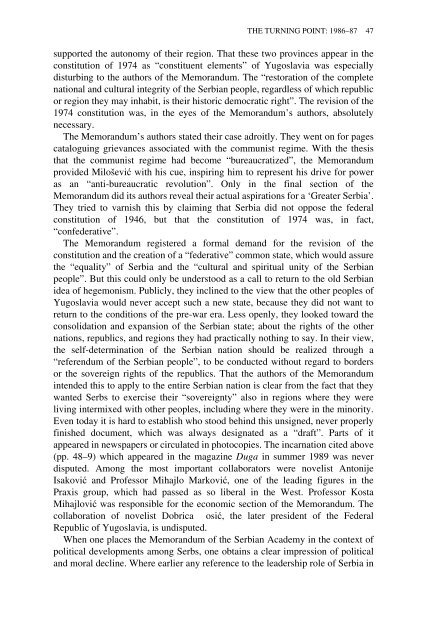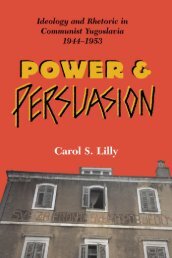Yugoslavia: A History of its Demise - Indymedia
Yugoslavia: A History of its Demise - Indymedia
Yugoslavia: A History of its Demise - Indymedia
You also want an ePaper? Increase the reach of your titles
YUMPU automatically turns print PDFs into web optimized ePapers that Google loves.
THE TURNING POINT: 1986–87 47<br />
supported the autonomy <strong>of</strong> their region. That these two provinces appear in the<br />
constitution <strong>of</strong> 1974 as “constituent elements” <strong>of</strong> <strong>Yugoslavia</strong> was especially<br />
disturbing to the authors <strong>of</strong> the Memorandum. The “restoration <strong>of</strong> the complete<br />
national and cultural integrity <strong>of</strong> the Serbian people, regardless <strong>of</strong> which republic<br />
or region they may inhabit, is their historic democratic right”. The revision <strong>of</strong> the<br />
1974 constitution was, in the eyes <strong>of</strong> the Memorandum’s authors, absolutely<br />
necessary.<br />
The Memorandum’s authors stated their case adroitly. They went on for pages<br />
cataloguing grievances associated with the communist regime. With the thesis<br />
that the communist regime had become “bureaucratized”, the Memorandum<br />
provided Milošević with his cue, inspiring him to represent his drive for power<br />
as an “anti-bureaucratic revolution”. Only in the final section <strong>of</strong> the<br />
Memorandum did <strong>its</strong> authors reveal their actual aspirations for a ‘Greater Serbia’.<br />
They tried to varnish this by claiming that Serbia did not oppose the federal<br />
constitution <strong>of</strong> 1946, but that the constitution <strong>of</strong> 1974 was, in fact,<br />
“confederative”.<br />
The Memorandum registered a formal demand for the revision <strong>of</strong> the<br />
constitution and the creation <strong>of</strong> a “federative” common state, which would assure<br />
the “equality” <strong>of</strong> Serbia and the “cultural and spiritual unity <strong>of</strong> the Serbian<br />
people”. But this could only be understood as a call to return to the old Serbian<br />
idea <strong>of</strong> hegemonism. Publicly, they inclined to the view that the other peoples <strong>of</strong><br />
<strong>Yugoslavia</strong> would never accept such a new state, because they did not want to<br />
return to the conditions <strong>of</strong> the pre-war era. Less openly, they looked toward the<br />
consolidation and expansion <strong>of</strong> the Serbian state; about the rights <strong>of</strong> the other<br />
nations, republics, and regions they had practically nothing to say. In their view,<br />
the self-determination <strong>of</strong> the Serbian nation should be realized through a<br />
“referendum <strong>of</strong> the Serbian people”, to be conducted without regard to borders<br />
or the sovereign rights <strong>of</strong> the republics. That the authors <strong>of</strong> the Memorandum<br />
intended this to apply to the entire Serbian nation is clear from the fact that they<br />
wanted Serbs to exercise their “sovereignty” also in regions where they were<br />
living intermixed with other peoples, including where they were in the minority.<br />
Even today it is hard to establish who stood behind this unsigned, never properly<br />
finished document, which was always designated as a “draft”. Parts <strong>of</strong> it<br />
appeared in newspapers or circulated in photocopies. The incarnation cited above<br />
(pp. 48–9) which appeared in the magazine Duga in summer 1989 was never<br />
disputed. Among the most important collaborators were novelist Antonije<br />
Isaković and Pr<strong>of</strong>essor Mihajlo Marković, one <strong>of</strong> the leading figures in the<br />
Praxis group, which had passed as so liberal in the West. Pr<strong>of</strong>essor Kosta<br />
Mihajlović was responsible for the economic section <strong>of</strong> the Memorandum. The<br />
collaboration <strong>of</strong> novelist Dobrica osić, the later president <strong>of</strong> the Federal<br />
Republic <strong>of</strong> <strong>Yugoslavia</strong>, is undisputed.<br />
When one places the Memorandum <strong>of</strong> the Serbian Academy in the context <strong>of</strong><br />
political developments among Serbs, one obtains a clear impression <strong>of</strong> political<br />
and moral decline. Where earlier any reference to the leadership role <strong>of</strong> Serbia in
















